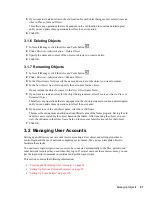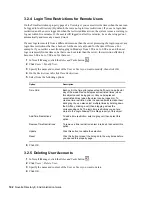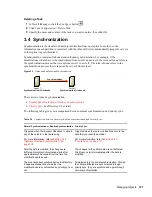
Managing Objects
111
n
ov
do
cx (e
n)
22
Ju
n
e 20
09
Synchronization Method
Normally, eDirectory automatically chooses the method based on the number of replicas and
replication partners. The following are the synchronization methods:
By Partition:
The modifications to data are synchronized simultaneously with other
replicas.Several threads are used to synchronize the modifications. For example, D1, D2, and
D3 are modifications to data on replica R1, and these have to be synchronized across replicas
R2 and R3, D1, D2, and D3 are simultaneously synchronized with R2 and R3.
By Server:
Modifications to data are synchronized sequentially. Only one thread is used to
sync the modifications. For example, D1, D2, and D3 are modifications to data on replica R1.
These have to be synchronized across replicas R2 and R3, D1 is first synchronized with R2 and
R3. Then D2 is synchronized with R2 and R3.
By Dynamic Adjust:
Based on the system resources you have allotted, eDirectory
automatically chooses the synchronization method.
Using iMonitor, you can specify the method of synchronization using
Agent Configuration
under
Agent Synchronization
. For more information, refer to
“Controlling and Configuring the DS Agent”
on page 206
.
3.4.3 Priority Sync
Priority Sync is one of the two synchronization processes in eDirectory. In eDirectory 8.8 and later,
you can use priority sync when you need to sync your critical data immediately and cannot wait for
normal synchronization.
Priority sync is complimentary to the normal synchronization process in eDirectory. Unlike normal
synchronization, in priority sync, the changes are not buffered before synchronizing them across the
servers. This makes priority sync faster than normal synchronization.
Priority sync is enabled by default. Refer to
“Enabling and Disabling Inbound and Outbound
Priority Sync” on page 112
for more information.
To sync the modifications to the critical data through priority sync:
1
Specify the number of threads for priority sync.
See
“Priority Sync Threads” on page 112
for more information.
2
Specify the priority sync queue size.
See
“Priority Sync Queue Size” on page 112
for more information.
3
Create and define a priority sync policy by identifying the critical attributes that you want to
sync as priority.
See
“Creating and Defining a Priority Sync Policy” on page 114
for more information.
4
Apply the priority sync policy to one or more partitions.
See
“Applying a Priority Sync Policy” on page 116
for more information.
The priority sync process is to sync only the modifications to the critical attributes. Priority sync
maintains the object transaction model. So, if noncritical data is modified and is not yet
synchronized, and if the critical data is changed for the same entry, the noncritical data along with
critical data is synchronized.
Summary of Contents for EDIRECTORY 8.8 SP5
Page 4: ...4 Novell eDirectory 8 8 Administration Guide novdocx en 22 June 2009...
Page 72: ...72 Novell eDirectory 8 8 Administration Guide novdocx en 22 June 2009...
Page 118: ...118 Novell eDirectory 8 8 Administration Guide novdocx en 22 June 2009...
Page 130: ...130 Novell eDirectory 8 8 Administration Guide novdocx en 22 June 2009...
Page 188: ...188 Novell eDirectory 8 8 Administration Guide novdocx en 22 June 2009...
Page 222: ...222 Novell eDirectory 8 8 Administration Guide novdocx en 22 June 2009...
Page 240: ...240 Novell eDirectory 8 8 Administration Guide novdocx en 22 June 2009...
Page 264: ...264 Novell eDirectory 8 8 Administration Guide novdocx en 22 June 2009...
Page 290: ...290 Novell eDirectory 8 8 Administration Guide novdocx en 22 June 2009...
Page 322: ...322 Novell eDirectory 8 8 Administration Guide novdocx en 22 June 2009...
Page 540: ...540 Novell eDirectory 8 8 Administration Guide novdocx en 22 June 2009...
Page 548: ...548 Novell eDirectory 8 8 Administration Guide novdocx en 22 June 2009...
Page 616: ...616 Novell eDirectory 8 8 Administration Guide novdocx en 22 June 2009...
















































